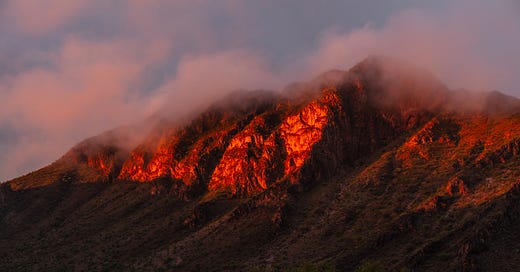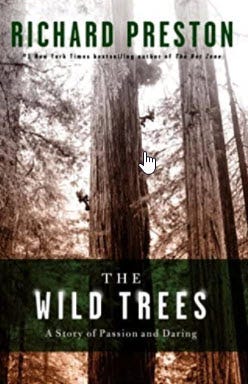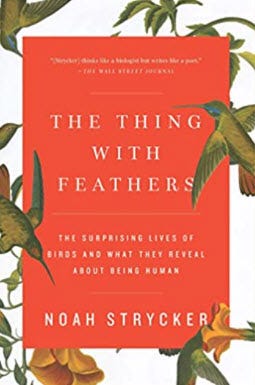Welcome! You’re at Mother E, a newsletter about nature, ecology, and climate, written by Robin Applegarth. To contact me, just respond to the email you were sent as a Mother E subscriber or leave a comment below. You can reach me on Twitter @RobinApplegarth
Feel free to share on social media or with friends.
In honor of Earth Week, I’m offering some favorite nature books, two entertaining documentaries, and a relevant essay about time.
The last article published, “A Gift From the Raven” brought lots of comments to my email box. It seems that Ravens have a secret fan club!
Sign up for Mother E below so you won’t miss what’s coming next.
Nature books to curl up with
Wild Trees—by Richard Preston
Preston’s account of the amazing world of giant old-growth redwood trees in Northern California is a true adventure story. Steve Sillett, Marie Antoine, and other naturalists, botanists, and adventurers brave danger and expand frontiers by climbing these tall trees hundreds of feet into the sky. The ancient redwoods support whole forest ecosystems of other species such as ferns, moss, and creatures living on them. Competition, secrecy, love, and endurance all combine to make this a fascinating true story. 320 pages
The Thing with Feathers—by Noah Strycker
The Surprising Lives of Birds and What They Reveal About Being Human
Written with gentle humor and a naturalist’s eye, this book holds broad appeal even to those who don’t fancy themselves as “bird-people.” From birds that woo with art to birds that travel the vast oceans of the world yet come back every year to meet up with the same mate, this book offers curious and pleasing stories. 304 pages
“The Thing With Feathers turns a shrewd, comparative eye on a succession of bird families to explore what [Strycker] calls their ‘human’ characteristics…This is an engaging work which illuminates something profound about all life, including our own.” – The Economist
Braiding Sweetgrass—by Robin Wall Kimmerer
This is a moving book with stories and deep wisdom from Kimmerer’s Potawatomi Nation background as well as her ethnobotanist science training. She also wrote “Gathering Moss,” and was the inspiration for my article Tiny Forests at our Feet—Inside the Secret World of Moss. 390 pages
“Robin Wall Kimmerer has written an extraordinary book, showing how the factual, objective approach of science can be enriched by the ancient knowledge of the indigenous people. It is the way she captures beauty that I love the most―the images of giant cedars and wild strawberries, a forest in the rain, and a meadow of fragrant sweetgrass will stay with you long after you read the last page.” Jane Goodall
Nature Documentaries
These have been out for a year or two, but are worth seeing if you missed them.
My Octopus Teacher—Documentary
This movie with Craig Foster won a 2021 Academy Award for Best Documentary Feature. It’s an emotional story of a relationship between a diver/filmmaker and an octopus. It covers how two species can communicate and bond when there is mutual respect and knowledge of the shared environment. This is one of those rare films that might change the way you view another species.
Available on Netflix. See the trailer below.
Fantastic Fungi—A documentary by Louie Schwartzberg
This is a visually rich film with an almost fairytale quality, including time-lapse photography. Fungal and mycelium networks may not sound sexy, but this film shows them to be key players in the health of forests and the planet. Notables such as Paul Stamets and others share their passion for mushrooms, including their healing qualities. This 2019 documentary is a lush view of the fungal network under our feet.
Available on Prime Video, other Stream-on-demand platforms, and here. See the trailer below.
Is Time on Our Side?
A report card for Earth Week 2021
By Robin Applegarth
High on the north slope of a dormant volcano on the Big Island of Hawaii sits an important measuring tool for humanity. It’s the Mauna Loa Observatory with its Global Monitoring Laboratory which rises high above the clouds at an elevation of 11,135 feet above sea level.
This lab measures gasses in Earth’s atmosphere daily. CO2 is one of the planetary gasses it measures. Elevated CO2 is causing global warming and a host of problems for Earth.
When I last checked this site on Earth Day, April 22, 2021, the CO2 levels were 418.57 parts per million by volume (ppmv). See what the CO2 level is today. For comparison, when I was born in the 1950s it was 312 ppmv. A “safe" level is deemed to be around 350 or less.
Why be concerned about this increase over time? Because this affects everyone and everything living that you love.
Whether you pay attention to the climate crisis or not, it’s not going away until we move faster towards a less toxic, more life-sustaining way of living that protects all species.
My motivation for paying attention is love for life—the family generations that follow and the plant and animal world that we are impacting. What will their world (and mine) be like in 10 or 20 more years-- with harsher and more unstable weather, a lower percentage of oxygen in the atmosphere, and predicted food and water shortages? Is this really the legacy we want to leave?
As part of the Baby Boomer generation, I have to painfully acknowledge that my lifestyle over decades contributed unwittingly to the problem. My household owns a car for each person, we’ve lived in middle-class homes that were spacious and full of the comforts considered “normal” in the U.S. but on a worldwide scale are almost lavish in size and amenities.
Getting a fresh perspective
My husband and I did a home exchange with a British couple many years ago, where we stayed in each other’s home for a few weeks. Their home was a historic converted carriage house on a wooded acre in the heart of England. We arranged the first couple of days to overlap so we could meet them in California. As we sat outside on the deck of a restaurant for a luncheon, the wife, Susan, commented, “Everything here is bigger: the cars, the homes, the stores, the refrigerators, even the squirrels!”
It took a foreigner to help me realize that the “American dream” was maybe an American excess. This “bigger” lifestyle has borrowed resources from the future and the loan has come due.
Earth’s natural resources (timber, freshwater, minerals, coal and oil, fish, wild plants, and animals) are being removed or destroyed too fast to be replenished. One study from the Global Footprint Network (2019) estimates it would take 5 Earths to support the human population if everyone’s consumption patterns were similar to the average American. Our planet is losing vital parts of what makes it livable for us. This can’t continue.
A decade calling for major Earth changes?
This week marked Earth Day in the U.S. on April 22. What we really need is Earth Decade.
A growing chorus of influential voices is saying the years 2021-2030 are pivotal action years if we want to keep a habitable planet. Fortunately, the Biden Administration has recognized this need and responded with a plan.
Also, the United Nations has declared a decade on Ecosystem Restoration. Here’s a statement from the UN website:
The UN Decade runs from 2021 through 2030, which is also the deadline for the Sustainable Development Goals and the timeline scientists have identified as the last chance to prevent catastrophic climate change.” UNFAO
“The UN Decade on Ecosystem Restoration is a rallying call for the protection and revival of ecosystems all around the world, for the benefit of people and nature. It aims to halt the degradation of ecosystems and restore them to achieve global goals. Only with healthy ecosystems can we enhance people’s livelihoods, counteract climate change, and stop the collapse of biodiversity.” UNFAO
When the normally non-dramatic UN says the decade of the 20s is “the last chance to prevent catastrophic climate change,” we all need to take a deep breath and pay attention.
Then there’s this statement about time tick-ticking on, from Dr. Jonathan Foley, who is a leading environmental scientist. Here’s what he wrote in an article in March 2021.
We already have tools to get started. What we don’t have is time to waste, and this next decade is critical.” Jonathan Foley, Ph.D., executive director of Project Drawdown — the world’s leading resource for climate solutions
Dr. Foley goes on to say scientists have determined we have to cut in half our current emissions in the next nine years if we want a chance of keeping a livable world. He says we have the solutions we need right now— they just need to be used on a much wider scale by more people, governments, and businesses.
Jonathan Foley has a 1-year old grandson, Levi, and I know he’s personally motivated in this cause.
The clock for change is ticking loudly. Is time on our side? I think the answer is— it depends upon how we use that time.
One thing we can all do is have more conversations about how to get to the safer, life-affirming future we all desire. One of humankind’s greatest talents is words. We learn from each other as well as from the species around us. Let’s share that learning and do more multi-solving together.
Here’s an article on multi-solving from Elizabeth Sawin, Co-Director of Climate Interactive, on the best ways to solve clusters of problems. She reminds us that, “Everyone matters; everyone is needed” and “storytelling” helps us to better imagine our future.
The next decade is likely to be challenging for people as well as all the other species as we navigate a mass extinction and the extreme changes Earth is undergoing. Let us be kind to ourselves, yet let us move forward with a sense of what a climate emergency really means.
Here’s a verse from an older poem by W. Lomax Childress, titled “Let Us Be Kind.”
The way is long and lonely,
And human hearts are asking for this blessing only
That we be kind.
We cannot know the grief that men may borrow,
We cannot see the souls storm-swept by sorrow,
But love can shine upon the way today, tomorrow
Let us be kind.W. Lomax Childress
What will our human legacy be? Can we learn to be “good ancestors” to future generations? Can we support the foundation for life on Earth to continue on its amazing, complex path? My hope is that we can find our collective love for Earth and each other, summon human ingenuity and act in time.
Here are two questions I leave with you:
1. What do you think is the hardest thing to change?
2. What do you care about deeply that motivates you to help your family, community, or planet?
If you want to share your answers with me, I may include them in future articles. Let’s continue this “conversation for our future.”
Robin A.
Author’s note: My household has now shifted to solar panels for our electricity and my next car will be an all-electric one once the Prius is worn out. We buy carbon offsets to put money towards solutions. We are phasing out as much plastic use as possible—that’s hardest for me! We are limiting unnecessary travel, composting our food scraps, and avoiding toxic chemicals to help the environment. It’s a gradual process of unwinding the cultural norms that got us into this mess. We’re not perfect, but the trajectory is now moving in the right direction and it feels good to be doing something to help. : )
Thanks for reading!





